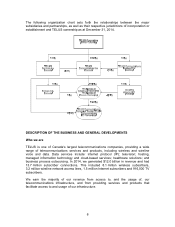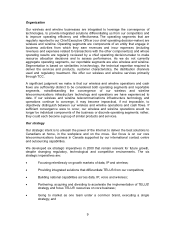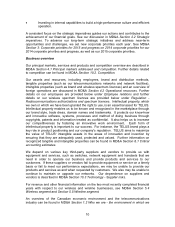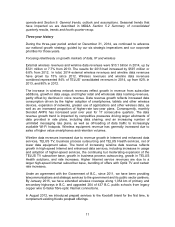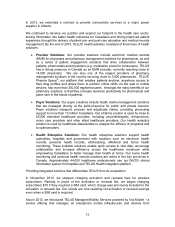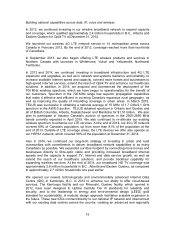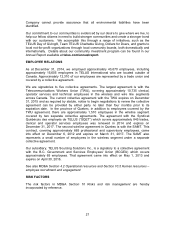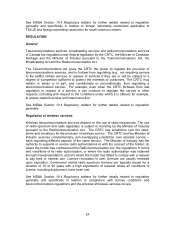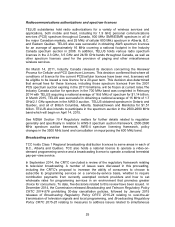Telus 2014 Annual Report Download - page 15
Download and view the complete annual report
Please find page 15 of the 2014 Telus annual report below. You can navigate through the pages in the report by either clicking on the pages listed below, or by using the keyword search tool below to find specific information within the annual report. 15
Building national capabilities across data, IP, voice and wireless
In 2012, we continued investing in our wireline broadband network to expand capacity
and coverage, which qualified approximately 2.4 million households in B.C., Alberta and
Eastern Quebec for Optik TV at December 31, 2012.
We launched our wireless 4G LTE network service in 14 metropolitan areas across
Canada in February 2012. By the end of 2012, coverage reached more than two-thirds
of Canadians.
In September 2013, we also began offering LTE wireless products and services in
Northern Canada with launches in Whitehorse, Yukon and Yellowknife, Northwest
Territories.
In 2013 and 2014, we continued investing in broadband infrastructure and 4G LTE
expansion and upgrades, as well as in network and systems resiliency and reliability, to
increase available Internet speed and capacity, connect more homes and businesses to
high-speed Internet services, extend the reach of Optik TV and enhance our healthcare
solutions. In addition, in 2014, we acquired and commenced the deployment of the
700 MHz wireless spectrum, which we have begun to operationalize for the benefit of
our customers. Spectrum in the 700 MHz range has superior propagation capabilities
that make it effective and efficient in covering Canada's expansive rural geography, as
well as improving the quality of in-building coverage in urban areas. In March 2015,
TELUS was successful in obtaining a national average of 15 MHz of 1.7 GHz/2.1 GHz
spectrum in the AWS-3 auction. TELUS obtained spectrum in Ontario and Quebec and
all of British Columbia, Alberta, Saskatchewan and Manitoba for $1.51 billion. We also
plan to participate in Industry Canada’s auction of spectrum in the 2500-2690 MHz
bands currently expected in April 2015. We also continued to re-allocate our existing
wireless spectrum to enhance our LTE services. At the end of 2014, our 4G LTE network
covered 89% of Canada’s population, up from more than 81% of the population at the
end of 2013. Outside of LTE coverage areas, the LTE devices we offer also operate on
our HSPA+ network, which covered 99% of the population at December 31, 2014.
Also in 2014, we continued our long-term strategy of investing in urban and rural
communities with commitments to deliver broadband network capabilities to as many
Canadians as possible. We expanded our fibre footprint by connecting more homes and
businesses directly to fibre-optic cable and providing increased broadband Internet
speeds and the capacity to support TV, Internet and data service growth, as well as
extend the reach of our healthcare solutions, and provide backhaul capability for
expanding wireless services. At the end of 2014, our broadband HD TV coverage was
approximately 2.8 million households in B.C., Alberta and Eastern Quebec, as compared
to approximately 2.7 million households one year earlier.
We opened our newest technologically and environmentally advanced Internet Data
Centre (IDC) in Kamloops, B.C. in 2013 to enhance our ability to offer cloud-based
services. The Kamloops facility and our Rimouski, Quebec facility, which opened in
2012, have been designed to Uptime Institute Tier III standards for reliability and
security, and to the leadership in energy and environmental design (LEED) gold
standard for sustainability. A modular design approach facilitates scalable expansion in
the future. These new IDCs connect directly to our national IP network and interconnect
with our existing data centres across the country, creating an advanced and regionally





